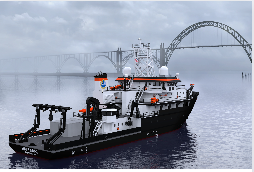The 60-metre-long newbuilds were designed by Glosten from Seattle, USA, in cooperation with Oregon State University.
The ships provide accommodation and workplace for up to sixteen scientists and are operated by a crew of thirteen. Their purpose is the exploration of the coastal marine environment.
As explained, the highest environmental protection requirements and the lowest possible noise emission played an important role in the development of the vessel design. The project is financed by the National Science Foundation (NSF) and managed by the abovementioned university.
The first of the three research vessels, RCRV Taani 1, will be launched this year and commissioned by the Oregon State University on the west coast as part of the University-Oceanographic Laboratory System (UNOLS).
According to Hamann, the sewage and wastewater management systems on board the vessels are designed to treat black water from toilets and grey water from showers, washbasins, kitchen sinks and laundries, and can process a peak of 6,000 litres of wastewater per day. Hamann HL-CONT PLUS 025 wastewater treatment plants with IMO MEPC.227(64) and USCG Type 2 (33 CFR 159) certification are used as a basis.
As explained, the Hamman Dissolved Air Flotation (DAF) technology used in these plants does not require any filters or membranes, enabling low-maintenance and reliability. Even strong fluctuations in the volume of wastewater to be treated due to fluctuating numbers of people on board are no problem for these plants.
The company’s grease separators separate the grease components from the galley wastewater to prevent clogging of the pipelines by grease deposits and the formation of hydrogen sulphide in holding tanks.
Automatically controlled Hamann tank aerators compensate for the lack of oxygen or oxygen consumption in the wastewater holding tanks, which, especially in connection with too high fat contents in the wastewater, promotes the formation of toxic and odorous hydrogen sulfide and ultimately of aggressive sulfuric acid, Hamann said.
Source: http://worldmaritimenews.com


